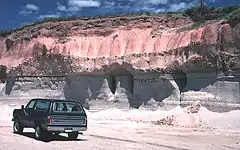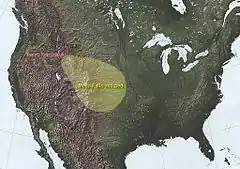| Mesa Falls eruption | |
|---|---|
 Mesa Falls Tuff exposed at southern rim of both the Island Park Caldera and the Henry's Fork Caldera near Ashton, Idaho. | |
| Volcano | Henry's Fork Caldera |
| Date | 1.3 million years ago |
| Type | Ultra-Plinian |
| Location | Idaho, United States 44°20′N 111°20′W / 44.33°N 111.33°W |
| Volume | 280 km3 (67 cu mi) |
| VEI | 7 |
 Extent of the Mesa Falls ash bed | |
The Mesa Falls Tuff is a tuff formation produced by the Mesa Falls eruption that formed the Henry's Fork Caldera that is located in Idaho west of Yellowstone National Park.[1] It is the second most recent caldera forming eruption from the Yellowstone hotspot and ejected of 280 km3 (67 cu mi) of material. This eruption, 1.3 million years BP, was preceded by the Huckleberry Ridge Tuff and succeeded by the Lava Creek Tuff, both of which were also formed by the Yellowstone hotspot.[2]
See also
References
- ↑ Christiansen, R.L., 2001, The Quaternary and Pliocene Yellowstone Plateau Volcanic Field of Wyoming, Idaho, and Montana: U.S. Geological Survey Professional Paper 729-G, 145 p.
- ↑ Yellowstone Caldera, Wyoming
This article is issued from Wikipedia. The text is licensed under Creative Commons - Attribution - Sharealike. Additional terms may apply for the media files.